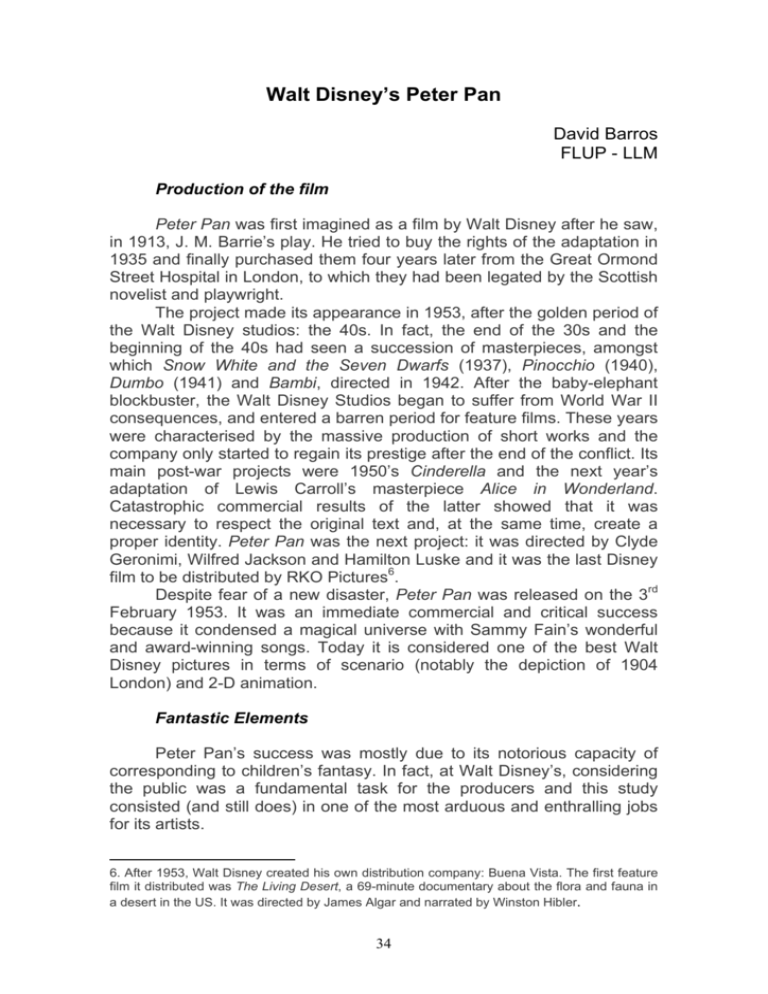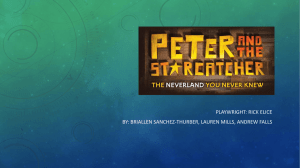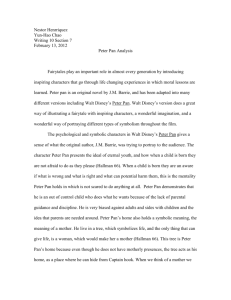Walt Disney's Peter Pan
advertisement

Walt Disney’s Peter Pan David Barros FLUP - LLM Production of the film Peter Pan was first imagined as a film by Walt Disney after he saw, in 1913, J. M. Barrie’s play. He tried to buy the rights of the adaptation in 1935 and finally purchased them four years later from the Great Ormond Street Hospital in London, to which they had been legated by the Scottish novelist and playwright. The project made its appearance in 1953, after the golden period of the Walt Disney studios: the 40s. In fact, the end of the 30s and the beginning of the 40s had seen a succession of masterpieces, amongst which Snow White and the Seven Dwarfs (1937), Pinocchio (1940), Dumbo (1941) and Bambi, directed in 1942. After the baby-elephant blockbuster, the Walt Disney Studios began to suffer from World War II consequences, and entered a barren period for feature films. These years were characterised by the massive production of short works and the company only started to regain its prestige after the end of the conflict. Its main post-war projects were 1950’s Cinderella and the next year’s adaptation of Lewis Carroll’s masterpiece Alice in Wonderland. Catastrophic commercial results of the latter showed that it was necessary to respect the original text and, at the same time, create a proper identity. Peter Pan was the next project: it was directed by Clyde Geronimi, Wilfred Jackson and Hamilton Luske and it was the last Disney film to be distributed by RKO Pictures6. Despite fear of a new disaster, Peter Pan was released on the 3rd February 1953. It was an immediate commercial and critical success because it condensed a magical universe with Sammy Fain’s wonderful and award-winning songs. Today it is considered one of the best Walt Disney pictures in terms of scenario (notably the depiction of 1904 London) and 2-D animation. Fantastic Elements Peter Pan’s success was mostly due to its notorious capacity of corresponding to children’s fantasy. In fact, at Walt Disney’s, considering the public was a fundamental task for the producers and this study consisted (and still does) in one of the most arduous and enthralling jobs for its artists. 6. After 1953, Walt Disney created his own distribution company: Buena Vista. The first feature film it distributed was The Living Desert, a 69-minute documentary about the flora and fauna in a desert in the US. It was directed by James Algar and narrated by Winston Hibler. 34 For a brief analysis of how the Peter Pan production team explored several aspects that met the expectations of a young public, we chose to examine a brief scene of the movie, which includes three of the most important elements: humour, the fantastic and the songs. In this sequence7, Peter Pan presents Tinker Bell to Wendy and her brothers, teaches them how to fly and then takes them over the skies of London to Neverland. Slapstick These six minutes are full of comical moments that correspond to the naïf sense of humour of children. In fact, these situations are characterised by a linear construction and avoid deep and referential wit. In truth, the most far-fetched situations offered by this scene are Tinker Bell’s insult to Wendy, telling her that she is “a big ugly girl”, or Michael’s tossing of pixie dust on Nana, the dog. Other humorous situations that replenish the movie in other moments are the gags between Captain Hook and Smee, which are openly influenced by Laurel and Hardy sketches8. Fantastic Peter Pan counts with two types of fantastic elements: those that correspond to a situation that could occur, but are so improbable that they become unreal, and those that present actions and descriptions that are impossible as being totally normal. In the first category fall, for example, the scenes between the pirates and the Londoners. The children could, in fact, fight against pirates, but that is so implausible that the whole scene completely belongs to the realm of fantasy. However, it is precisely this unlikelihood that assumes itself as the attractive element of their adventures. Therefore, it is totally understandable that John cries out: “I should like very much to cross swords with some real buccaneers” and Michael adds: “Yes, and fight pirates!”. Besides, when John has to think about “a wonderful thought” in order to be able to fly, he says “I’ll think I’m in a pirate’s cave!”. For the second group, the most obvious example is that of the children’s flight to Neverland. The fact that this has been, for many centuries, a long-wished but completely vain human endeavour, flying remains one of children’s foremost dreams. Thus, the pixie dust presented by Peter Pan points to the existence of a substance that, although not generally known (and that is why no one that the young spectator actually knows can fly), permits its few possessors to challenge the laws of gravity. In this respect, Disney filmmakers had a most notable work, because flying is one of the most difficult illusions to create in two7. Minutes 15 to 21. 8. Their physical contrast, one being extremely tall and slim and the other fat and short, is one of the most evident proofs of this. 35 dimensional animation without the aid of computers. Most notable is also the work on shadows, with are today easily made in 3D animation, but were particularly difficult to depict in the 1950s. Songs Finally, the songs included in Peter Pan have a very important role in children’s acceptance and appraisal of the movie. As in many other youth-directed films, they were written in a melodic fashion and their lyrics were created so that they could easily be learnt by heart. The awardwinning score, conceived by Sammy Fain, includes: “The Second Star to the Right”, “You can fly!”, “A Pirate’s Life”, “Follow the Leader” and “The Elegant Captain Hook”. Case Study: Tinker Bell Out of the fantastic universe created by the authors of Peter Pan, stands out Tinker Bell, the Disney version of the Barrie self-confident and egotist fairy. In comparison to the previous representations of the pixie, Walt Disney’s is by far the most revolutionary. Previously, in all stage productions, Tinker Bell had never been interpreted by an actor. She was normally depicted as no more than a light, and so drawers from the Disney team had almost complete freedom in the act of giving a face, body and expressions for the new character. Dancer and choreographer Margaret Kerry was used as its live-action reference model and her constitution had obvious traces of the World War II American Pin Ups. She hence reflected the female beauty canon of late 40s and 50s. For the young eye, her magnetism is essentially due to her ability to fly and to make others fly by the use of her pixie dust9, her small size that permitted her to hide everywhere and her beauty as a mini-sized diva. 9. The yellowish hue of the pixie dust demonstrates how children are oft times attracted to brilliant objects, mainly gold. A curious parallel can be established here with J. R. R. Tolkien’s bestseller The Hobbit, where Bilbo Baggins sets out for a perilous quest after a reward in gold. 36 Similarities and differences between the book and the film The Barrie book and the Disney film present a big number of elements that match and of facets that are completely distinct. Firstly, the 1953 movie respects the narrative lines and the main personal characteristics. Peter Pan, for example, is as cocky, courageous and forgetful as he is in the book, just as Tinker Bell is as jealous, but possibly in a slightly less sexual way. The most important moral values followed by the book are also maintained by the Disney feature, such as the pricelessness of youth and the importance of family. In terms of the elements that separate the two art forms in their treatment of the story, two main kinds can be distinguished: those that are totally irrelevant for the narrative (and that only suit technical and prosaic impositions), and those that alter significantly the general purpose and aspect of the work. In the first group can be included changes in names or redefinitions of lesser physical and psychological features of some characteristics. The Disney producers, for example, changed the name of Neverland in NeverNeverland and, although in Barrie’s text Hook lost his right hand, the Disney artists relocated his hook to the left hand, because otherwise it would limit his actions too much. The bigger differences are more related to other kind of constrictions. In fact, two main reasons are behind the most significant variations between the film and the book. First, the Disney Studios had to deal with budget and time limitations, which were naturally absent from the creation of the novel. This impeded the adaptation of many elements that remain, to this day, exclusive to Barrie’s work. Secondly, the film producers had to ensure that the film could be seen by younger audiences, which evidently implied a reshaping of content of the text. Consequently, the most violent parts of the book are softened in the movie. For example, whereas in the play and the novel Tinker Bell gets knocked out by a poison, in the animated film she gets hurt by a bomb. Besides, the picture rejects a certain humour developed by Barrie that was intended for adults. The most well-known case is that of a brilliant conversation between the Darling couple, discussing whether it would be possible to have Wendy or not: “I have one pound seventeen here, and two and six at the office; I can cut off my coffee at the office, say ten shillings, making two nine and six, with your eighteen and three makes three nine seven, with five naught naught in my cheque-book makes eight nine seven – who is that moving? – eight nine seven, dot and carry seven – don’t speak, my own – and the pound you lent to that man who 37 came to the door – quiet, child – dot and carry child – there, you’ve done it! – did I say nine nine seven? Yes, I said nine nine seven; the question is, can we try it for a year on nine nine seven?” “Of course we can, George,” she cried. But she was prejudiced in Wendy’s favour, and he was really the grander character of the two. “Remember mumps,” he warned her almost threateningly, and off he went again. “Mumps one pound that is what I have put down, but I daresay it will be more like thirty shillings – don’t speak – measles one five, German measles half a guinea, makes two fifteen six – don’t waggle your finger – whooping cough, say fifteen shillings” – and so on it went, and it added up differently each time; but at last Wendy just got through, with mumps reduced to twelve six, and the two kinds of measles treated as one.” (Peter Pan: I). On the other hand, some characters lost psychological profoundness in the film adaptation. Captain Hook and even Peter Pan are more schematic than in novel. This linearity is also reflected in broader terms: the second layer of analysis is somewhat lost in the adaptation. While James Barrie created a work that would have one meaning for youths and another for adults, the Disney picture merely focuses on the adventurous side of the story and gives only slight hints about the importance of family. Moreover, the film finishes, in narrative terms, earlier than the book, not only because of time limitations, but because the Disney studios did not want to give Barrie’s more complex ending to their young viewers10. In fact, the author of Peter Pan ends his novel in a much less hermetic way than the movie. He writes a chapter that incorporates Nietzsche’s “eternal return” concept and that attributes an allegoric status to the novella: generation after generation, children will dream of overcoming their physical and social limitations to live adventures in their minds. This is not only impossible to avoid but is essential for a harmonious and healthy growth: “As you look at Wendy you may see her hair becoming white, and her figure little again, for all this happened long ago. Jane is now a common grown-up, with a daughter called Margaret; and every spring-cleaning time, except when he forgets, Peter comes for Margaret and takes her to the Neverland, where she tells him stories about himself, to which he listens eagerly. When Margaret grows up she will have a daughter, who is to be Peter’s mother in turn; and thus it will go on, so long as children are gay and innocent and heartless.” (Peter Pan: XVII). 10. Barrie’s epilogue refers to old age, and the theme of ageing always makes children ill at ease, for it scares them. 38 Conclusion Walt Disney’s Peter Pan is an extremely interesting case of a wellsucceeded adaptation of an excellent novel. Not only is it enthralling to analyse how the transcodification was made by the Disney studios (contemplating, of course the similarities and the differences between both mediums) but also to appreciate the artistic manoeuvres, totally handmade, that were used to create the illusion of reality in such a magical world. But most interesting of all, I believe, is to study how the movie was able to search for and find the correct tone to meet the high expectations of children all over the world and still does, today, 54 years later. Peter Pan: Child/Adult Relationship and the Narrative Strategies of Time(s) and Spaces(s) Ana Teresa Magalhães Vera Patrícia Leal FLUP – LLM This essay will focus on the adult/child as well as on the time/ space relationships in J. M. Barrie´s Peter Pan.1 Some parallels will be traced between two distinct worlds presented in the book: the real world, on the one hand, as reflected by the Victorian social background underlying the whole narrative; the imaginary world of Neverland, on the other. It is however extremely significant to point out briefly some relevant aspects regarding Victorian society. Generally speaking, it was a very strict society, though highly industrialized and hard working, ruled by narrow moral values and almost entirely submitted to a patriarchal social order. Children and childhood were beginning then to be sensed as particular problems of the time, with their own needs and demands to which there were no definite answers. Specially children from the lower, working classes were forced to work hard in extremely bad conditions, both human and sanitary, living short and dreadful lives with hardly any possibilities of finding a way out from their families’ long established misery. They worked usually eight to twelve hours per day, six days a week, had no access to education, and even playing with other children was scarcely allowed to them by parents or any other kind of adult tutor or teacher. Apart from their natural liveliness and willingness to live life in full, often assailed by illnesses that cut short their hopes and future prospects, these were unhappy children, often treated very much as slaves, earning little more than nothing to help with the household daily expenses. Nevertheless, it was in Victorian times that education and the welfare of children began to be a theme of concern to many physicians, psychologists, pedagogues and educators in general. Books for children seem to have first appeared as a consequence of children’s unhappiness, as they tried to give 39






